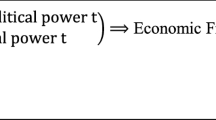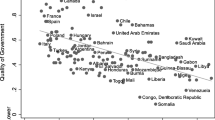Abstract
This paper investigates the hypothesis that the association between property rights institutions and income is weaker in countries with high social divisions. It argues that social divisions should have a negative effect on perceived institutional inclusiveness, which in turn should depress institutional payoffs. Absent a property rights indicator that captures the perceived inclusiveness of institutions, social divisions should then weaken the observed association between property rights institutions and income. The empirical results support this hypothesis, and highlight the importance of evaluating whether the institutions measure used captures the institutional framework applying to the population at large.
Similar content being viewed by others
References
Acemoglu, D., Johnson, S., & Robinson, J. A. (2001). The colonial origins of comparative development: an empirical investigation. American Economic Review, 91(5), 1369–1401.
Acemoglu, D., Johnson, S., & Robinson, J. A. (2002). Reversal of fortune: geography and institutions in the making of the modern world income distribution. The Quarterly Journal of Economics, 117(4), 1231–1293.
Aghion, P., Alesina, A., & Trebbi, F. (2004). Endogenous political institutions. The Quarterly Journal of Economics, 119(2), 565–611.
Alesina, A., Devleeschaauwer, A., Easterly, W., Kurlat, S., & Wacziarg, R. (2003). Fractionalization. Journal of Economic Growth, 8(2), 155–194.
Alesina, A., & La Ferrara, E. (2005). Ethnic diversity and economic performance. Journal of Economic Literature, 43, 762–800.
Alesina, A., & Perotti, R. (1996). Income distribution, political instability and investment. European Economic Review, 81(5), 1170–1189.
Alesina, A., & Rodrik, D. (1994). Distribution politics and economic growth. The Quarterly Journal of Economics, 109, 465–490.
Anthias, F. (1998). Rethinking social divisions: some notes towards a theoretical framework. The Sociological Review, 46(3), 505–535.
Baliamoune-Lutz, M. (2005). Institutions, social capital, and economic development in Africa: an empirical study. International Centre for Economic Research Working Paper Series, No. 18.
Baliamoune-Lutz, M., & Ndikumana, L. (2007). The growth effects of openness to trade and the role of institutions: new evidence from African countries (Working Paper 2007-05). University of Massachusetts Amherst.
Barro, R. J. (2000). Inequality and growth in a panel of countries. Journal of Economic Growth, 5(1), 5–32.
Basuchoudhary, A., & Shughart II, W. F. (2007). On ethnic conflict and the origins of transnational terrorism (Mimeo).
Bazzi, S., & Clemens, M. (2009). Blunt instruments: on establishing the causes of economic growth (Working paper number 171). Centre for Global Development.
Benabou, R. (1996). Inequality and growth. NBER Macroeconomics Annual 1996, 11–73.
Besley, T., & Ghatak, M. (2009). Property rights and economic development. Centre for Economic Policy Research Discussion Paper Series, No. 7243.
Bourguignon, F., & Morrison, C. (1990). Income distribution, development and foreign trade. European Economic Review, 34(6), 1113–1132.
Braumoeller, B. F. (2004). Hypothesis testing and multiplicative interaction terms. International Organization, 58, 807–820.
Brock, W. A., & Durlauf, S. N. (2001). Growth empirics and reality. The World Bank Economic Review, 15(2), 229–272.
Cappelen, A. W., Hole, A. D., Sørensen, E. Ø., & Tungodden, B. (2007). The pluralism of fairness ideals: an experimental approach. The American Economic Review, 97, 818–827.
Cavalcanti, T., & Novo, A. (2005). Institutions and economic development: how strong is the relation? Empirical Economics, 30(2), 263–276.
Chong, A., & Gradstein, M. (2007). Inequality and institutions. The Review of Economics and Statistics, 89(3), 454–465.
Collier, P. (2000). Ethnicity, politics and economic performance. Economics and Politics, 12(3), 225–245.
Collier, P. (2001). Implications of ethnic diversity. Economic Policy, 116(32), 127–167.
Collier, P., & Hoeffler, A. (2004). Greed and grievance in civil war. Oxford Economic Papers, 56(4), 563–595.
Deaton, A. (2009). Instruments of development: randomization in the tropics, and the search for the elusive keys to economic development (Mimeo). Princeton University
Deininger, K., & Squire, L. (1996). A new dataset measuring income inequality. World Bank Economic Review, 10(3), 565–591.
Djankov, S., Glaeser, E., La Porta, R., Lopez-de-Silanes, F., & Shleifer, A. (2003). The new comparative economics. Journal of Comparative Economics, 31, 595–619.
Dollar, D., & Kraay, A. (2003). Institutions, trade, and growth. Journal of Monetary Economics, 50, 133–162.
Easterly, W. (2001a). Global Development Network Growth Database. Available at http://econ.worldbank.org/WBSITE/EXTERNAL/EXTDEC/EXTRESEARCH/0,,contentMDK:20701055~pagePK:64214825~piPK:64214943~theSitePK:469382,00.html. Accessed 5 March 2010.
Easterly, W. (2001b). The middle class consensus and economic development. Journal of Economic Growth, 6, 317–335.
Easterly, W., & Levine, R. (1997). Africa’s growth tragedy: policies and ethnic divisions. Quarterly Journal of Economics, 112(4), 1203–1250.
Easterly, W., Ritzen, J., & Woolcock, M. (2006). Social cohesion, institutions, and growth. Economics and Politics, 18(2), 103–120.
Eicher, T., & Leukert, A. (2006). Institutions and economic performance: endogeneity and parameter heterogeneity (Working Paper January 2006). University of Washington Ifo Institute for Economic Research and Ludwig-Maximilians-Universität München.
Eifert, B., Miguel, E., & Posner, D. N. (2009). Political competition and ethnic identification in Africa (Mimeo).
Erdmann, G. (2007). The cleavage model, ethnicity and voter alignment in Africa: conceptual and methodological problems revisited (Working paper No. 63). German Institute of Global and Area Studies (GIGA).
Esteban, J.-M., & Ray, D. (1994). On the measurement of polarization. Econometrica, 62(4), 819–851.
Fearon, J. D. (2003). Ethnic and cultural diversity by country. Journal of Economic Growth, 8, 195–222.
Fong, C. (2001). Social preferences, self-interest, and the demand for redistribution. Journal of Public Economics, 82, 225–246.
Frankel, J. A., & Romer, D. (1999). Does trade cause growth? American Economic Review, 89(3), 379–399.
Gallup, J. L., Sachs, J. D., & Mellinger, A. D. (1998). Geography and economic development. National Bureau of Economic Research Working Paper, No. w6849.
Galor, O., & Zeira, J. (1993). Income distribution and macroeconomics. Review of Economic Studies, 60(1), 35–52.
Glaeser, E. L., La Porta, R., Lopez-De-Silanes, F., & Shleifer, A. (2004). Do institutions cause growth? Journal of Economic Growth, 9, 271–303.
Glaeser, E., Scheinkman, J., & Shleifer, A. (2003). The injustice of inequality. Journal of Monetary Economics, 50(1), 199–222.
Goldstein, M., & Udry, C. (2008). The profits of power: land rights and agricultural investment in Ghana. Journal of Political Economy, 116(6), 981–1022.
Hall, R. E., & Jones, C. I. (1999). Why do some countries produce so much more output per worker than others? The Quarterly Journal of Economics, 114(1), 83–116.
Hardin, R. (1995). One for all: the logic of group conflict. Princeton: Princeton University Press.
Hellman, J., & Kaufmann, D. (2002). The inequality of influence (Draft for presentation at Stanford Corruption Workshop, January 2003).
Heritage Foundation (2007). The index of economic freedom. http://www.heritage.org.
Hoff, K., & Stiglitz, J. E. (2004). After the big bang? Obstacles to the emergence of the rule of law in post-communist societies. The American Economic Review, 94(3), 753–763.
Hoffman, E., & Spitzer, M. L. (1985). Entitlements, rights, and fairness: an experimental examination of subjects’ concepts of distributive justice. Journal of Legal Studies, 14, 259–297.
Horowitz, D. L. (1985). Ethnic groups in conflict. Berkeley: University of California Press.
Isaksson, A. (2009). Social divisions and institutions: assessing institutional parameter variation (Working Papers in Economics, No. 282). University of Gothenburg.
Isaksson, A., & Lindskog, A. (2009). Preferences for redistribution: a country comparison of fairness judgments. Journal of Economic Behavior and Organization, 72(3), 884–902.
Kaufmann, D., Kraay, A., & Zoido-Lobatón, P. (1999). Governance matters (Working paper No. 2196). Washington, DC: World Bank.
Keefer, P., & Knack, S. (2002). Polarization, politics and property rights: links between inequality and growth. Public Choice, 111, 127–154.
Knack, S., & Keefer, P. (1995). Institutions and economic performance: cross-country tests using alternative institutional measures. Economics and Politics, 7(3), 207–227.
Kumaranayake, L., & Vyas, S. (2006). Constructing socio-economic status indices: how to use principal component analysis. Health Policy and Planning, 21(6), 459–468.
Kuznets, S. (1955). Economic growth and income inequality. The American Economic Review, 45(1), 1–28.
La Porta, R., Lopez-de-Silanes, F., Shleifer, A., & Vishny, R. (1999). The quality of government. Journal of Law, Economics and Organization, 15(1), 222–279.
Leeson, P. T. (2005). Endogenizing fractionalization. Journal of Institutional Economics, 1(1), 75–98.
Lindberg, S. I., & Morrison, M. K. C. (2008). Are African voters really ethnic or clientelistic? Survey evidence from Ghana. Political Science Quarterly, 123(1), 95–122.
Luxembourg Income Study (2009). Key figures. Available at http://www.lisproject.org/key-figures/key-figures.htm. Accessed 5 March 2010.
Mehlum, H., Moene, K., & Torvik, R. (2006). Institutions and the resource curse. The Economic Journal, 116, 1–20.
Montalvo, J. G., & Reynal-Querol, M. (2005). Ethnic polarization, potential conflict and civil wars. The American Economic Review, 95(3), 796–816.
Mozaffar, S., Scarritt, J. R., & Galaich, G. (2003). Electoral institutions, ethnopolitical cleavages, and party systems in Africa’s emerging democracies. American Political Science Review, 97(3), 379–390.
Mukand, S. W., & Rodrik, D. (2005). In search of the Holy Grail: policy convergence, experimentation, and economic performance. American Economic Review, 95(1), 374–383.
North, D. (1990). Institutions, institutional change and economic performance. Cambridge: Cambridge University Press.
North, D. C. (1994). Economic performance through time. The American Economic Review, 84, 359–368.
Persson, T., & Tabellini, G. (1994). Is inequality harmful for growth? The American Economic Review, 84(3), 600–621.
Rodrik, D. (1999). Where did all the growth go? External shocks, social conflict, and growth collapses. Journal of Economic Growth, 4, 385–412.
Rodrik, D. (2008). Second best institutions (NBER Working Paper No. W14050, June 2008).
Rodrik, D., Subramanian, A., & Trebbi, F. (2004). Institutions rule: the primacy of institutions over geography and integration in economic development. Journal of Economic Growth, 9, 131–165.
Sachs, J. D., & Warner, A. M. (1995). Economic reform and the process of global integration. Brooking Papers on Economic Activity, 1, 1–118.
Sachs, J. D. (2003). Institutions don’t rule: direct effects of geography on per capita income. NBER Working Paper, No. 9490, NBER.
Temple, J. (2000). Growth regressions and what the textbooks don’t tell you. Bulletin of Economic Research, 52(3), 181–205.
Solt, F. (2009). Standardizing the world income inequality database. Social Science Quarterly, 90(2), 231–242. SWIID Version 2.0, July 2009.
Sonin, K. (2003). Why the rich may favor poor protection of property rights. Journal of Comparative Economics, 31(4), 715–731.
Tam, H. (2008). An economic or political Kuznets curve? Public Choice, 134(3–4), 367–389.
Williamson, C. R. (2009). Informal institutions rule: institutional arrangements and economic performance. Public Choice, 139(3–4), 371–387.
World Bank (2007). Doing business project: economy rankings. Available at http://www.doingbusiness.org/economyrankings/. Accessed 5 March 2010.
World Economic Forum (2008). The global competitiveness report 2008–2009. World Economic Forum, Geneva.
Zietz, J. (2006). Detecting neglected parameter heterogeneity with Chow tests. Applied Economics Letters, 13, 369–374.
Author information
Authors and Affiliations
Corresponding author
Rights and permissions
About this article
Cite this article
Isaksson, AS. Social divisions and institutions: assessing institutional parameter variation. Public Choice 147, 331–357 (2011). https://doi.org/10.1007/s11127-010-9632-7
Received:
Accepted:
Published:
Issue Date:
DOI: https://doi.org/10.1007/s11127-010-9632-7




